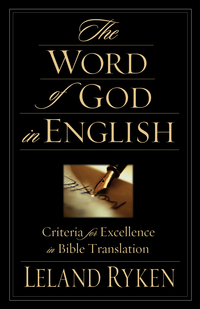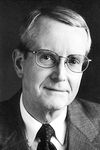Leland Ryken: The Word of God in English
 Leland Ryken, The Word of God in English: Criteria for Excellence in Bible Translation (Wheaton, IL: Crossway Books, 2002), 336 pages.
Leland Ryken, The Word of God in English: Criteria for Excellence in Bible Translation (Wheaton, IL: Crossway Books, 2002), 336 pages.
When reviews are written of new books, there is often a temptation to use such phrases as “ground-breaking” or “most important book of the year/decade/century.” At the risk of adding yet another such review, the term “ground-breaking” does seem to be appropriate to apply to Dr. Ryken’s latest book. Dr. Leland Ryken is professor of English at Wheaton College, and recently served as a literary stylist for the English Standard Version of the Bible (ESV), published in 2001 by Crossway Books. In addition to his teaching, and his work on the ESV, Dr. Ryken has written several books on the literary styles and analysis of the Bible, and so brings both qualifications and credentials to a discussion on the literary aspects of Bible translation.
Dr. Ryken aims to answer the question which has been in the thoughts of many Christians: “How does one determine which the best type of Bible translation?” Although his initial criterion was literary, his work on the ESV led Dr. Ryken to examine other aspects of Bible translation, which are discussed in this book. In the end, it comes down to a comparison between two basic types of translations:
- Dynamic equivalent translations, such as the New International Version (NIV) and the New Living Translation (NLT); and
- Essentially literal translations, such as the King James Version (KJV), the New American Standard Bible (NASB), and the English Standard Version (ESV).

Leland Ryken served as professor of English at Wheaton College for over 43 years.
At the same time, Dr. Ryken is quick to differentiate between the concepts of “essentially literal” translation theory and “formal equivalent” translation theory. On page 19 he defines “formal equivalence” as “a theory of translation that favors reproducing the form or language of the original text, and not just its meaning. In its stricter form, this theory of translation espouses reproducing even the syntax and word order of the original.” Dr. Ryken is correct in pointing out that formal equivalence would produce a translation that would be unreadable to the average reader. C. John Collins, in his appendix to the book, mentions the ending of Exodus 20:17 (the Tenth Commandment) as an example. A formal equivalent translation would reproduce the Hebrew word order as “and all which to your neighbor,” which of course makes no sense according to all the rules of English grammar. However, the ESV (essentially literal) translates it as “or anything that is your neighbor’s,” which makes sense according to the English language while remaining faithful to the original Hebrew text.
In the very preface of his book, Dr. Ryken informs his readers right at the outset that he favors essentially literal translations over dynamic equivalent translations, and gives this explanation of how that applies to translation theory:
By an essentially literal translation I do not mean one that renders the original text so literally as to be incomprehensible to English readers. The syntax must be English rather than Hebrew or Greek, and idioms that are incomprehensible to English readers need to be rendered in terms of meaning rather than literal equivalence. But within the parameters of these necessary deviations from the original, an essentially literal translation applies the same rules as we expect from a published text in its original language: The author’s own words are reproduced, figurative language is retained instead of explained, and stylistic features and quirks of the author are allowed to stand as the author expressed them (p. 10).
In a very detailed and thorough volume, Dr. Ryken discusses a wide variety of topics ranging from the mundane (for example, if we value Shakespeare’s writings enough not to consider changing the literary form of the words he used, why would we change the literary form of the words used in the Word of God?) to the vital (for example, if we truly believe in the verbal plenary inspiration of the Scriptures, how could we ever consider changing the very words used when we translate them into English?). Along the way, Dr. Ryken treats us to a summary of the history of Bible translation into English, explores some of the fallacies believed regarding the Bible, translation, and the readers of the Bible, and spends a good third of the book discussing the literary excellence required in faithful translation theory.
Category: Biblical Studies, Winter 2004


